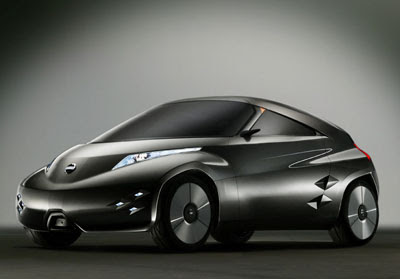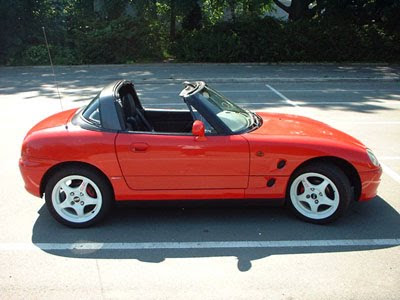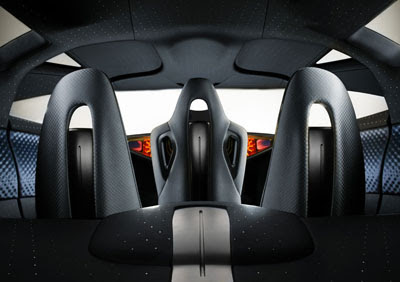Saturday, October 31, 2009

Production began in earnest at the Kosai plant in October 1991, although aspirations for the car never extended beyond the domestic market. Aware of the favourable reception the car was receiving in its homeland, Suzuki GB soon spotted the potential for the Cappuccino to act as a brand builder for the marque, and entered into discussions to bring the car to these shores.Being such a specialist car, the type approval process wasn't straightforward, yet the Cappuccino officially went on sale to an initially bemused British public in October 1993, priced at £11,995. Tougher emissions regulations eventually made the import of the Cappuccino unfeasible, but the car carried on for sale in Japan in Type2 guise until late 1997, and personally imported examples continue to hit UK docks.

Production began in earnest at the Kosai plant in October 1991, although aspirations for the car never extended beyond the domestic market. Aware of the favourable reception the car was receiving in its homeland, Suzuki GB soon spotted the potential for the Cappuccino to act as a brand builder for the marque, and entered into discussions to bring the car to these shores.Being such a specialist car, the type approval process wasn't straightforward, yet the Cappuccino officially went on sale to an initially bemused British public in October 1993, priced at £11,995. Tougher emissions regulations eventually made the import of the Cappuccino unfeasible, but the car carried on for sale in Japan in Type2 guise until late 1997, and personally imported examples continue to hit UK docks.

Production began in earnest at the Kosai plant in October 1991, although aspirations for the car never extended beyond the domestic market. Aware of the favourable reception the car was receiving in its homeland, Suzuki GB soon spotted the potential for the Cappuccino to act as a brand builder for the marque, and entered into discussions to bring the car to these shores.Being such a specialist car, the type approval process wasn't straightforward, yet the Cappuccino officially went on sale to an initially bemused British public in October 1993, priced at £11,995. Tougher emissions regulations eventually made the import of the Cappuccino unfeasible, but the car carried on for sale in Japan in Type2 guise until late 1997, and personally imported examples continue to hit UK docks.

Production began in earnest at the Kosai plant in October 1991, although aspirations for the car never extended beyond the domestic market. Aware of the favourable reception the car was receiving in its homeland, Suzuki GB soon spotted the potential for the Cappuccino to act as a brand builder for the marque, and entered into discussions to bring the car to these shores.Being such a specialist car, the type approval process wasn't straightforward, yet the Cappuccino officially went on sale to an initially bemused British public in October 1993, priced at £11,995. Tougher emissions regulations eventually made the import of the Cappuccino unfeasible, but the car carried on for sale in Japan in Type2 guise until late 1997, and personally imported examples continue to hit UK docks.

Production began in earnest at the Kosai plant in October 1991, although aspirations for the car never extended beyond the domestic market. Aware of the favourable reception the car was receiving in its homeland, Suzuki GB soon spotted the potential for the Cappuccino to act as a brand builder for the marque, and entered into discussions to bring the car to these shores.Being such a specialist car, the type approval process wasn't straightforward, yet the Cappuccino officially went on sale to an initially bemused British public in October 1993, priced at £11,995. Tougher emissions regulations eventually made the import of the Cappuccino unfeasible, but the car carried on for sale in Japan in Type2 guise until late 1997, and personally imported examples continue to hit UK docks.

Production began in earnest at the Kosai plant in October 1991, although aspirations for the car never extended beyond the domestic market. Aware of the favourable reception the car was receiving in its homeland, Suzuki GB soon spotted the potential for the Cappuccino to act as a brand builder for the marque, and entered into discussions to bring the car to these shores.Being such a specialist car, the type approval process wasn't straightforward, yet the Cappuccino officially went on sale to an initially bemused British public in October 1993, priced at £11,995. Tougher emissions regulations eventually made the import of the Cappuccino unfeasible, but the car carried on for sale in Japan in Type2 guise until late 1997, and personally imported examples continue to hit UK docks.

The Mixim concept car is a compact vehicle for young drivers who are mostly engaged by their computer and the world via the internet. Powered by Nissan’s ‘Super Motor’ electric motor/generator and using compact lithium-ion batteries, Mixim has unusually rapid performance combined with a usefully extended range. One Super Motor powers the front axle and a second drives the rear axle, giving Mixim all-wheel drive. Mixim takes the most up-to-date electric vehicle (EV) technology and clothes.
Labels: luxury car, Nissan, sport car

The Mixim concept car is a compact vehicle for young drivers who are mostly engaged by their computer and the world via the internet. Powered by Nissan’s ‘Super Motor’ electric motor/generator and using compact lithium-ion batteries, Mixim has unusually rapid performance combined with a usefully extended range. One Super Motor powers the front axle and a second drives the rear axle, giving Mixim all-wheel drive. Mixim takes the most up-to-date electric vehicle (EV) technology and clothes.
Labels: luxury car, Nissan, sport car

The Mixim concept car is a compact vehicle for young drivers who are mostly engaged by their computer and the world via the internet. Powered by Nissan’s ‘Super Motor’ electric motor/generator and using compact lithium-ion batteries, Mixim has unusually rapid performance combined with a usefully extended range. One Super Motor powers the front axle and a second drives the rear axle, giving Mixim all-wheel drive. Mixim takes the most up-to-date electric vehicle (EV) technology and clothes.
Labels: luxury car, Nissan, sport car

The Mixim concept car is a compact vehicle for young drivers who are mostly engaged by their computer and the world via the internet. Powered by Nissan’s ‘Super Motor’ electric motor/generator and using compact lithium-ion batteries, Mixim has unusually rapid performance combined with a usefully extended range. One Super Motor powers the front axle and a second drives the rear axle, giving Mixim all-wheel drive. Mixim takes the most up-to-date electric vehicle (EV) technology and clothes.
Labels: luxury car, Nissan, sport car

The Mixim concept car is a compact vehicle for young drivers who are mostly engaged by their computer and the world via the internet. Powered by Nissan’s ‘Super Motor’ electric motor/generator and using compact lithium-ion batteries, Mixim has unusually rapid performance combined with a usefully extended range. One Super Motor powers the front axle and a second drives the rear axle, giving Mixim all-wheel drive. Mixim takes the most up-to-date electric vehicle (EV) technology and clothes.
Labels: luxury car, Nissan, sport car
Subscribe to:
Comments (Atom)







